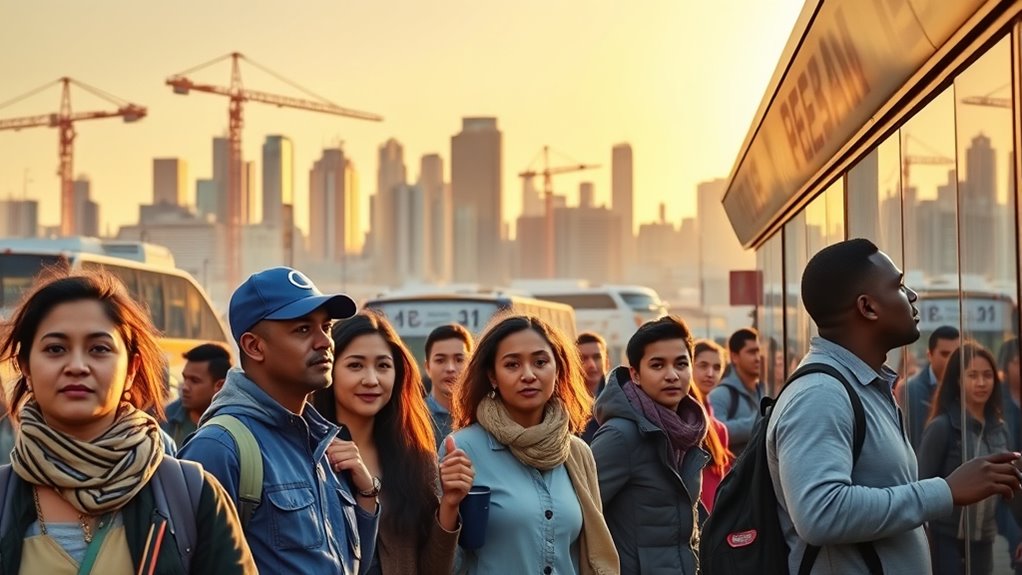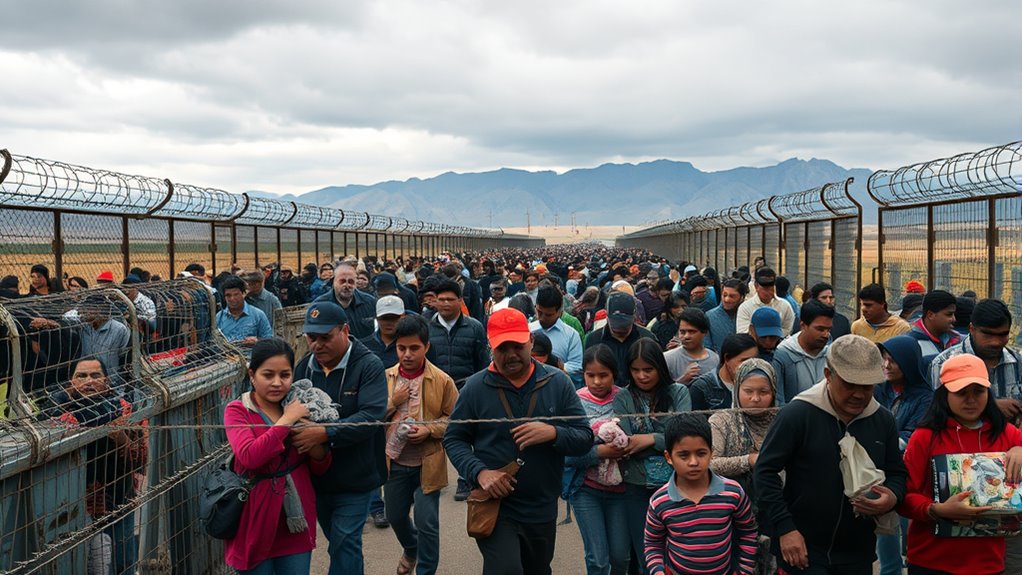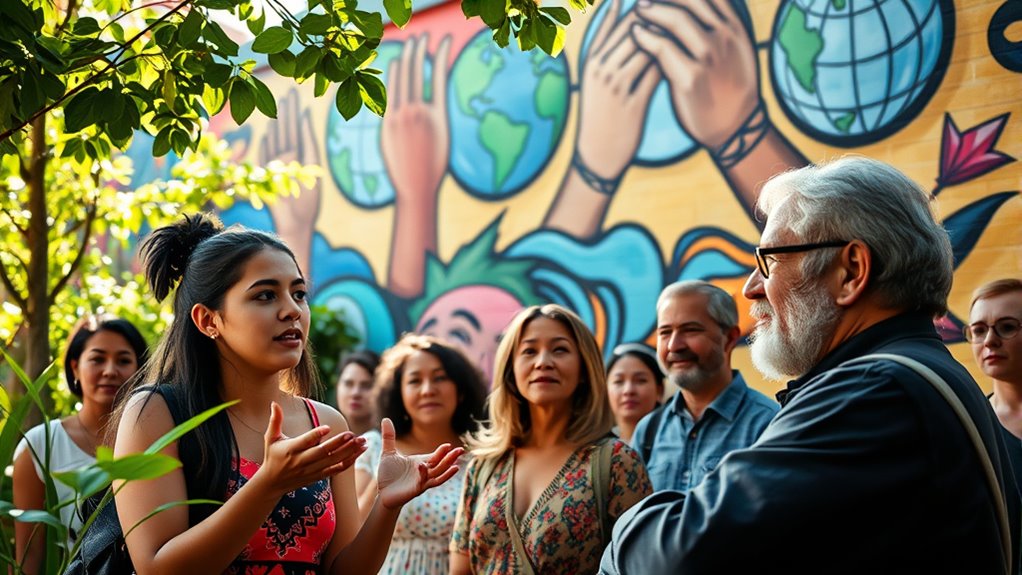Understanding immigration requires distinguishing facts from fears. Personal stories and media influence shape perceptions—highlighting resilience and contributions can build empathy, while sensationalized coverage fosters suspicion. Evidence shows immigrants boost the economy, fill essential jobs, and are less likely to commit crimes. Compassionate policies and accurate information help dispel myths and promote trust. If you want a clearer view of the realities behind immigration, exploring these perspectives further can provide valuable insights.
Key Takeaways
- Personal stories humanize immigration issues, fostering understanding and countering negative stereotypes fueled by fear-based media framing.
- Evidence shows immigrants contribute positively to the economy, fill labor shortages, and have lower crime rates, challenging misconceptions.
- Accurate information and community dialogue build trust, dispel myths, and promote empathy over fear in immigration narratives.
- Compassionate policies emphasizing human dignity and integration improve societal cohesion and address root causes of migration.
- Media portrayal influences public perception; highlighting positive contributions helps shift narratives from fear to facts.
The Power of Personal Stories in Immigration Discourse

Have you ever wondered why personal stories resonate so deeply in immigration debates? It’s because they showcase the power of cultural exchange and personal resilience. When immigrants share their experiences, they reveal how they adapt to new environments, fostering understanding and empathy. These stories humanize complex issues, moving beyond statistics to show real struggles and triumphs. Personal resilience shines through as individuals overcome barriers, demonstrating strength and determination. Their narratives encourage others to see immigrants as more than stereotypes, highlighting the richness added to society through diverse backgrounds. By sharing these stories, you help bridge gaps, challenge misconceptions, and foster a more compassionate dialogue about immigration’s true human impact. Recognizing the significance of personal storytelling can significantly influence public perceptions and policy discussions.
Common Myths and Misconceptions About Immigrants

Many common myths about immigrants persist despite ample evidence to the contrary, shaping public perceptions and policies. One misconception is that immigrants struggle with cultural integration, but many adapt quickly, contributing to their communities. Some believe language barriers prevent effective participation, yet many immigrants learn the language and engage actively in society. These myths ignore the resilience and resourcefulness of newcomers who often face challenges head-on. The idea that immigrants are unwilling to integrate or learn the language is outdated; in reality, most endeavor to communicate and connect. Recognizing these truths helps dispel fear and misinformation, revealing that immigrants are enthusiastic to become valued members of their new communities, despite misconceptions about cultural barriers or language difficulties. Additionally, understanding the importance of emotional alignment can foster more empathy and support for immigrant integration efforts.
The Economic Impact of Immigration: What the Data Shows

Immigration can considerably boost workforce productivity and stimulate economic growth. When immigrants fill labor shortages and start new businesses, they contribute to overall prosperity. The data clearly shows that immigration is a powerful driver of economic progress. Additionally, supporting resources and tools for integration and development can maximize these benefits.
Boosts Workforce Productivity
When immigrants enter the workforce, they often bring valuable skills and innovative perspectives that can directly enhance productivity. Their contributions strengthen the labor market and open new levels of efficiency. By filling skill gaps, they help businesses operate more effectively. Their diverse backgrounds foster innovation potential, inspiring fresh ideas and solutions. This infusion of talent leads to higher output and better competitiveness. Here are some key points:
- Increase in overall labor market flexibility
- Acceleration of technological advancements
- Diversification of skills and expertise
- Higher employment rates for all workers
- Enhanced competitiveness of industries
Your active participation in welcoming immigrant workers can considerably boost workforce productivity, ensuring a more dynamic and resilient economy driven by diverse talent and innovation. Recognizing the importance of projector technology can also inspire innovative strategies in various fields, including workforce development and economic growth.
Drives Economic Growth
The infusion of immigrant talent not only boosts productivity but also greatly accelerates overall economic growth. When immigrants enter the labor market, they fill essential roles across industries, increasing output and innovation. This expands market size, creates new opportunities, and drives consumer spending. Additionally, cultural diversity enriches the economy by encouraging creativity and new ideas, fostering a dynamic business environment. Immigrants often start businesses, generating jobs and contributing to tax revenues. These effects combine to strengthen the economy’s resilience and capacity for growth. Overall, immigration acts as a catalyst for a more vibrant, competitive labor market, fueling sustained economic development while broadening cultural perspectives that benefit society as a whole. Recognizing the importance of essential roles filled by immigrants highlights how their integration supports economic stability and expansion.
Safety and Security: Separating Fact From Fiction

Many myths about immigration and security persist, but understanding the facts can help you see through the misinformation. Contrary to popular belief, immigration does not markedly increase crime rates. In fact, crime statistics often show that immigrant communities tend to have lower crime rates than native-born populations. When it comes to border security, extensive measures are in place to prevent illegal crossings, and these efforts are effective. Here are some key points to consider:
Myth-busting: Immigration lowers crime rates and border security measures are effective.
- Most unauthorized crossings are detected and managed by border security agencies
- Crime rates among immigrant populations are generally lower
- Extensive surveillance and technology improve border security
- Fears about immigrants causing violence are not supported by data
- Crime statistics show no link between immigration and higher crime levels
Implementing border security measures has contributed to maintaining safety and reducing illegal crossings.
Understanding these facts helps you distinguish between fear-driven myths and reality.
Immigration Policies: Evidence-Based Approaches vs. Emotional Responses

While emotions often drive debates about immigration, evidence-based policies focus on what truly benefits society. You can promote effective cultural integration by designing legal reforms that support newcomers in accessing education, employment, and community resources. Instead of reacting to fears, policymakers should rely on data showing how well-structured legal reforms facilitate social cohesion and economic growth. These approaches prioritize clear, measurable outcomes, such as reduced integration barriers and increased civic participation. Innovative strategies rooted in environmental innovations can also help create sustainable communities that are resilient to future challenges. Emotional responses often lead to restrictive policies that hinder immigrant contributions and create division. By emphasizing evidence-based strategies, you help craft immigration policies rooted in fairness and practicality. This approach fosters a welcoming environment where diversity enriches communities and strengthens national resilience.
Media Influence on Public Perceptions of Immigrants

Media outlets shape public perceptions of immigrants by framing stories in ways that can either foster understanding or reinforce stereotypes. Your perception of immigration is heavily influenced by media framing, which highlights certain narratives over others. When stories focus on negative aspects, such as crime or economic strain, they sway public opinion toward fear and suspicion. Conversely, positive coverage emphasizing contributions and diversity can promote empathy. Additionally, the way stories are presented can be affected by media framing techniques, which influence the overall narrative and public perception.
The Humanitarian Perspective: Compassion in Immigration Debates

You recognize that every person deserves dignity, regardless of where they come from. Compassionate policies prioritize human needs and reflect our shared values. By focusing on empathy, we can create immigration debates that are more humane and just. Embracing the art of Italian espresso can also serve as a symbol of hospitality and cultural appreciation across communities.
Emphasizing Human Dignity
Understanding the importance of human dignity is essential to fostering compassion in immigration debates. When you prioritize human dignity, you recognize that every individual deserves respect and ethical considerations, regardless of their background. This perspective shifts the focus from fear to empathy, emphasizing the intrinsic worth of migrants. Acknowledging breast cancer symptoms and health considerations underscores the importance of respecting individuals’ well-being in all contexts. Consider these key points: – Every person is deserving of respect and humane treatment. – Ethical considerations should guide immigration policies. – Recognizing shared humanity fosters understanding and compassion. – Devaluing human dignity leads to discrimination and injustice. – Compassionate approaches uphold fundamental human rights.
Policies With Compassion
Policies grounded in compassion prioritize the humane treatment of migrants and recognize their inherent dignity. These approaches focus on facilitating cultural integration, helping newcomers build lives with respect and support. By embracing policy reform that centers on empathy, you create systems that address root causes and promote inclusion. Consider the table below, which highlights key elements of compassionate policies:
| Element | Impact |
|---|---|
| Cultural integration | Fosters community cohesion and understanding |
| Policy reform | Ensures fair, humane treatment and opportunities |
Building Bridges: Promoting Understanding Through Accurate Information

Building bridges between diverse communities begins with sharing accurate and reliable information. When you focus on facts, you foster understanding and reduce misconceptions around immigration. Promoting community integration and cultural exchange helps break down barriers and builds trust. To effectively promote understanding, consider these key points:
- Share stories that highlight positive immigrant contributions
- Dispel myths with evidence-based data
- Encourage open dialogue and questions
- Highlight successful examples of cultural exchange
- Use local events to foster community integration
Frequently Asked Questions
How Do Immigration Statistics Vary Across Different Countries?
You’ll notice immigration statistics differ widely across countries due to factors like economic disparities and border security measures. Countries with stronger economies often attract more immigrants, while others tighten border controls, reducing numbers. These variations reflect policies and economic conditions, shaping how many people move and settle. Understanding these differences helps you see that immigration patterns aren’t just about numbers but also about economic opportunities and border security strategies.
What Are the Long-Term Societal Benefits of Immigration?
Imagine society as a garden, thriving with diverse plants. Immigration brings long-term benefits, fueling economic growth and balancing demographic shifts. You see, newcomers often introduce fresh skills and ideas, boosting innovation and productivity. Over time, this diversity strengthens communities, making them more resilient and adaptable. Embracing immigration’s positive impact helps create a vibrant, dynamic society where everyone can flourish, much like a well-tended garden bursting with life.
How Do Immigration Policies Impact Undocumented Immigrants?
Immigration policies directly impact undocumented immigrants by shaping their legal status and opportunities. You might face legal challenges, such as deportation or limited access to services, which can hinder your stability. However, these policies also affect your economic contributions, as stricter rules can reduce your ability to work and contribute to communities. Understanding these impacts helps you navigate the system and advocate for fair treatment and better inclusion.
What Role Does Language Proficiency Play in Immigrant Integration?
Think of language proficiency as your gateway, much like the key to Pandora’s box. When you overcome language barriers, you boost your chances of integration success, connecting with communities and opportunities. Clear communication builds trust and understanding, making daily interactions smoother. Your language skills influence how well you adapt and thrive in a new environment, turning obstacles into stepping stones on your journey toward belonging and success.
How Do Cultural Differences Influence Immigration Debates?
You see, cultural differences considerably influence immigration debates by highlighting issues like cultural misunderstandings and identity preservation. These differences can lead to misunderstandings, making it harder to find common ground. You might also worry about losing your cultural identity, which fuels debates. Recognizing that these concerns are natural helps you understand why discussions can become heated, but embracing diversity can foster more inclusive, respectful conversations about immigration.
Conclusion
By blending brave beliefs with balanced facts, you can break down barriers and build bridges. Embrace empathy, explore evidence, and challenge misconceptions to change the conversation. When you prioritize truth over fear, you foster fairness and forge futures filled with understanding. Let your voice be vibrant, vigilant, and visionary—because only through compassion and clarity can we create a welcoming world where everyone’s story is valued and voices are heard.









